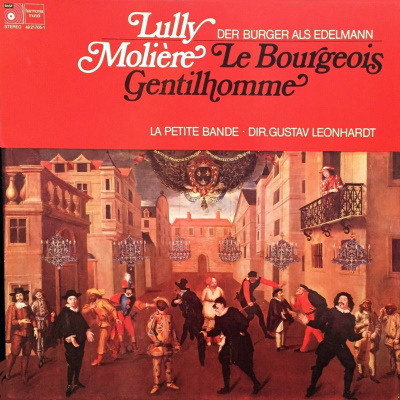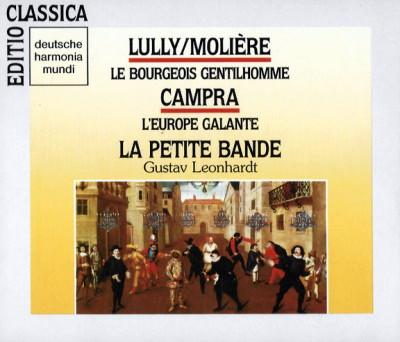 |
|
2 LPs
- 49 21705-1 - (p) 1973
|
 |
| 2 CDs -
GD 77059 - (c) 1990 |
|
LE BOURGEOIS
GENTILHOMME - Jean-Baptiste Molière
|
|
|
|
|
|
|
|
| Jean-Baptiste
LULLY (1632-1687) |
Comédie-Ballet
1670
|
|
|
|
|
- Ouverture
|
|
3' 03" |
A1 |
|
- Air ·
L'élève de Musique
|
|
2' 41" |
A2 |
|
- Air · La
Musicienne |
|
1' 28" |
A3 |
|
- Dialogue en Musique |
|
14' 05" |
A4 |
|
- Air
|
|
3' 14" |
A5 |
|
- 1er Air |
|
1' 12" |
B1 |
|
- 2e Air
(Gavotte)
|
|
1' 02" |
B2 |
|
- 1ère
Chanson à boire
|
|
0' 44" |
B3 |
|
- 2e Chanson
à boire |
|
1' 20" |
B4 |
|
La
Cérémonie Turque
|
|
14' 13" |
B5 |
|
Ballet
des Nations |
|
|
|
|
- Première
Entrée
|
|
8' 42" |
C1 |
|
- Seconde
Entrée
|
|
1' 15" |
C2 |
|
- Troisième
Entrée
|
|
12' 57" |
C3 |
|
-
Quatrième Entrée |
|
9' 33" |
D1 |
|
-
Cinquième Entrée
|
|
5' 52" |
D2 |
|
-
Sixième Entrée
|
|
2' 57" |
D3 |
|
|
|
|
|
Siegmund Nimsgern,
Bariton (Muphiti)
Dirk Schortemeier, Bariton
(Elève)
Rachel Yakar, Sopran
(Musicienne)
René Jacobs, Contratenor
(1. Musicien)
Dirk Schortemeier, Bariton (2.
Musicien)
Klaus Heider, Tenor (3.
Musicien)
Norbert Lohmann, Tenor (4.
Musicien)
Franz Müller-Heuser, Bariton
(5. Musicien)
Michel Lecoq, Tenor (1.
Homme du bel air)
Norbert Lohmann, Tenor (2.
Homme du bel air)
Maria Friesenhausen, Sopran
(1. Femme du bel air)
Dorothea Jungmann, Sopran
(2. Femme du bel air)
René Jacobs, Contratenor (Gascon)
Klaus Heider, Tenor (Autre
Gascon)
Dirk Schortemeier, Bariton (Suisse)
Franz
Müller-Heuser, Bariton
(Vieux bourgeois)
Dirk
Schortemeier, Bariton
(Vieille
bourgeoise)
Dorothea
Jungmann, Sopran (Italienne)
Michel
Lecoq, Tenor (Italien)
Michel
Lecoq, Tenor (1. Espagnol)
Franz
Müller-Heuser, Bariton
(2. Espagnol)
Dirk
Schortemeier,
Bariton (3.
Espagnol)
René Jacobs, Contratenor (1.
Poitevin)
Klaus
Heider, Tenor (2. Poitevin)
Tölzer Knabenchor (Solisten
und Mitglieder), Les douze
Turcs, Les Français
|
LA PETITE BANDE
/ Sigiswald Kuijken, Konzertmeister
/ Gustav LEONHARDT, Leitung
- Lucy van Dael, Ruth
Hesselingh, Jan Reichow, Janine
Rubinlicht, Dirk Verelst, Violine
- Marten Boeken, Marleen Thiers,
Marie Leonhardt, Janneke van der
Meer, Wiel Peeters, Martin
Sonneveld, Viola
- Anner Bylsma, Wielan Kuijken,
Richte van der Meer, Jordi Savall, Violoncello
- Bruce Haynes, Christian Lange, Blockflöte
- Bruce Haynes, Pol Dombrecht,
Pieter Dhont, Ku Ebbinge, Oboe
- Christian Lange, Peter Mauruschat,
Fagott
- Gustav Leonhardt, Bob van Asperen,
Cembalo
- Michael Schäffer, Theirbe
- Ralph Peinkofer, Schlagzeug
|
|
|
|
|
|
Luogo
e data di registrazione |
|
Cedernsaal, Schloß
Kirchheim, (Germany) - 1973
|
|
|
Registrazione: live
/ studio |
|
studio |
|
|
Recording
Supervision |
|
Dr. Thomas Gallia |
Paul Dery
|
|
|
Engineer |
|
Sonart, Milano
|
|
|
Prima Edizione LP |
|
Harmonia Mundi (Basf)
| 49 21705-1 | 2 LPs - durata 43'
00" - 41' 16" | (p) 1973
|
|
|
Edizione CD |
|
Deutsche
Harmonia Mundi | LC 00761 |
GD 77059 | 2 CDs - durata
66' 01" - 68' 09" | (c) 1990
| ADD
|
|
|
Cover Art
|
|
Farceurs italiens
& français (c. 1600)
|
|
|
Note |
|
- |
|
|
|
|
|
The 17th
century in France was the
“grand siècle" of a
classical art in the strict
sense of the word. In the
observance of the three
Aristotelian unities of
time, place and action, in
the refined elegance of the
language, the grammatical
order of which had its
origin in the 16th century,
finally in the control over
the passions Corneille’s and
Racine’s dramas and
Molière‘s comedies
demonstrated how much they
kept to classical ideas.
Music was not an art
expressing human passions,
but rather a dignified or an
elaborate and gay
decoration.
In France dramatic music was
closely connected with
dancing, first of all with
courtly dancing, then with
ballet. Since the 16th
century the special form
ofthe ballet de cour
had existed, favoured by the
French liking for an orderly
elegance, for a society
moving in exact geometrical
forms. The ballet de
cour consisted of a
varying number of Entrées,
that means sequences of
dances and explanatory
verses, the so-called Récits,
that were spoken or sung.
That is why the Entrées
were not only presented
purely instrumentally, but
were accompanied by
polyphonic choirs and
solo-songs with lute
accompaniment, the Airs
de cour.
The new development of the ballet
de cour is continued
by Molière’s works
who, together with Lully,
writes the new comédies-bullets,
one of them a poet und actor
entering into the heritage
of the Commedia dell'arte,
the other one a dancer and
organizer. The cooperation
with Molière, already tested
for some years, reached its
prolific climax with lhe
triad of the years 1669/70:
Monsieur de Pourceaugnac,
Les Amants magnifiques, Le
Bourgeois gentilhomme.
Lully created a wreat
musical form now combining
all the elements of the ballet
de cour in a new style
of the French opera. Social
criticism and smiling at the
frailty of men, however,
were banished from these
operas, the heroes of a
mythical history ruled,
giving an example of the
greatness of the
all-magnificent King of
Versailles even on stage.
When Lully came to the
French court, he lound the
famous orchestra of the Vingt-quatre
violons du roi. This
form of the orchestra, that
was a little clumsy, was
given up by Lully in favour
of a smaller star orchestra,
in which the outer parts
were now dominating in an
extraordinary manner. La
Petite Bande takes
over just the same
instrumentation (and the
name) of the
Lully-orchestra: 6 violins
and 4 oboes for the first
voice, 2 altos for each of
the ,,parties”, 4
violoncellos and 2 bassoons
for the fifth voice. The
instruments of the Petite
Bande consist of a
great number of French
original instruments of the
17th and the early 18th
century and of some Old
Italian instruments.
|
  |
|
|